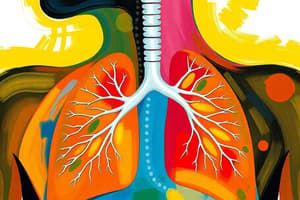Podcast
Questions and Answers
What is the primary function of cellular respiration?
What is the primary function of cellular respiration?
Which stage of cellular respiration occurs in the presence of oxygen?
Which stage of cellular respiration occurs in the presence of oxygen?
What term describes the process of exchanging gases (particularly oxygen and carbon dioxide) between an organism and its environment?
What term describes the process of exchanging gases (particularly oxygen and carbon dioxide) between an organism and its environment?
In which part of the body does gas exchange occur in humans?
In which part of the body does gas exchange occur in humans?
Signup and view all the answers
When is anaerobic respiration primarily used by organisms?
When is anaerobic respiration primarily used by organisms?
Signup and view all the answers
What is the essential role of blood in the respiratory system?
What is the essential role of blood in the respiratory system?
Signup and view all the answers
Where does gas exchange primarily occur in the human respiratory system?
Where does gas exchange primarily occur in the human respiratory system?
Signup and view all the answers
Which type of respiration yields more ATP due to the complete oxidation of glucose molecules?
Which type of respiration yields more ATP due to the complete oxidation of glucose molecules?
Signup and view all the answers
In humans, what triggers the process of exhalation?
In humans, what triggers the process of exhalation?
Signup and view all the answers
Which gas is primarily transported by red blood cells in the bloodstream?
Which gas is primarily transported by red blood cells in the bloodstream?
Signup and view all the answers
What is the primary role of the trachea in the human respiratory system?
What is the primary role of the trachea in the human respiratory system?
Signup and view all the answers
Why does anaerobic respiration produce ATP more quickly than aerobic respiration?
Why does anaerobic respiration produce ATP more quickly than aerobic respiration?
Signup and view all the answers
Study Notes
Respiration: Breathing Life into Cells and Bodies
Respiration, a fundamental process for all living organisms, plays a crucial role in sustaining life. It involves a series of chemical reactions that convert biochemical energy stored in molecules into a form that cells can use, as well as removing waste products. In this article, we'll explore the aspects of respiration—cellular, gas exchange, aerobic and anaerobic, and the human respiratory system—while also touching upon the essential role of blood in delivering oxygen and nutrients to cells.
Cellular Respiration
Cellular respiration is a sequence of metabolic reactions occurring within the cells of living organisms. It functions to break down energy-rich molecules like glucose, releasing energy in the form of ATP, which cells use as an energy source. There are three main stages in cellular respiration: glycolysis, the citric acid cycle (also known as the Krebs cycle or TCA cycle), and oxidative phosphorylation. The majority of cellular respiration occurs in the presence of oxygen (aerobic respiration), but some organisms, like muscle cells during intense exercise, can resort to anaerobic respiration when oxygen is scarce.
Gas Exchange
Gas exchange refers to the process of exchanging gases (particularly oxygen and carbon dioxide) between an organism and its environment. In humans, gas exchange occurs in the lungs during the process of breathing. Gases diffuse across the thin, moist membrane of the alveoli and into the bloodstream, which then transports them to the body's cells and tissues. Gas exchange is a critical aspect of respiration because it allows cells to obtain oxygen and remove waste carbon dioxide.
Aerobic vs Anaerobic Respiration
Aerobic respiration is a metabolic process that occurs in the presence of oxygen, while anaerobic respiration happens in the absence of oxygen. Aerobic respiration generates more ATP than anaerobic respiration, due to the complete oxidation of glucose molecules. However, anaerobic respiration can occur more rapidly and produce ATP more quickly than aerobic respiration, making it useful in short-term bursts of energy production. Both forms of respiration have their uses and occur at different times and in different organisms.
Breathing Mechanisms
Breathing mechanisms enable the exchange of gases between the lungs and the external environment. In humans, breathing is an involuntary process, meaning that the body regulates it automatically, without conscious effort. The process of breathing involves inhalation (the act of drawing air into the lungs), exhalation (the act of expelling air from the lungs), and the interplay of muscles and structures that make up the respiratory system.
The Human Respiratory System
The human respiratory system is a complex network of organs and tissues that facilitate gas exchange. It consists of the nose, mouth, pharynx, larynx, trachea, bronchi, and lungs. The lungs are the primary organs of the respiratory system, where gas exchange occurs. The breathing process begins with the inhalation of air through the nose or mouth, which passes through the pharynx and larynx and into the trachea. The trachea branches into the bronchi, which further branch into bronchioles, and eventually into the alveoli. The alveoli are where gas exchange occurs.
Blood
Blood plays a vital role in the respiratory system, as it transports oxygen and nutrients to tissues and organs and removes waste products, including carbon dioxide. The red blood cells in the blood contain hemoglobin, a protein that binds to oxygen molecules and releases them at the cellular level. Hemoglobin is crucial for transporting oxygen and carbon dioxide throughout the body.
Although this article touches upon many aspects of respiration, it serves as an introduction to the subject. A more comprehensive understanding of these processes requires more in-depth study and exploration of the scientific literature. So, delve deeper into the world of respiration and unlock the secrets of life itself!
Studying That Suits You
Use AI to generate personalized quizzes and flashcards to suit your learning preferences.
Description
Explore the intricate processes of respiration including cellular respiration, gas exchange, aerobic and anaerobic respiration, and the human respiratory system. Understand how organisms convert energy-rich molecules into ATP, exchange gases with the environment, and transport oxygen and nutrients through the bloodstream.




